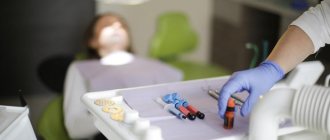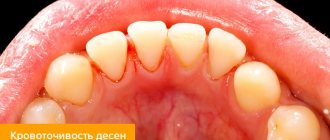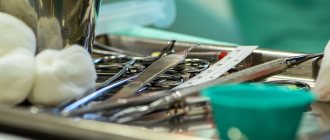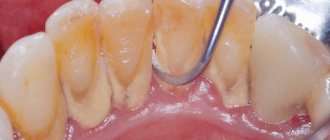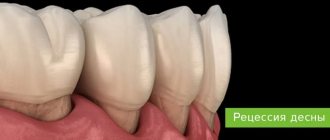Modern methods of professional teeth cleaning are safe and comfortable for the patient. The procedure can be performed even during pregnancy.
Complex cleaning is practically painless; in very rare cases, anesthesia is required. Removal of hard dental deposits and soft plaque is carried out in several stages:
- Tartar removal. First, all hard dental deposits are removed. The procedure is carried out using ultrasound.
- Cleansing using the Air Flow device. Under the influence of water pressure containing abrasive particles, tooth enamel is not only cleaned of soft plaque, but also whitened to its natural shade.
- Polishing. After brushing, the surface of the teeth becomes slightly rough, which will contribute to the rapid accumulation of plaque. To avoid this, the tooth surface is treated with special discs and bristles. After the procedure, the enamel becomes smooth and protected from the effects of pathogenic microflora.
- Treatment with antiseptics. To prevent the spread of infection and to prevent gum inflammation, the oral cavity is treated with an antiseptic solution.
- Fluoridation. After cleaning, the teeth are coated with fluoride varnish to strengthen and reduce the sensitivity of the enamel.
- Applying therapeutic bandages. In case of severe gum inflammation and periodontal bleeding, special therapeutic dressings are applied. The dressings may contain antiseptics, antiviral drugs, and antibiotics.
Causes of enamel hyperesthesia
Many patients complain of increased sensitivity of teeth after tartar removal. The main reason for such complaints is the exposure of hard tooth tissues that were previously covered with tartar. The deposits partially reduced the impact of irritants - high and low temperatures, sour, sweet and spicy foods. Therefore, after the stone is removed, the enamel reacts more sharply to external factors.
Increased tooth sensitivity is caused by:
- existing diseases of the oral cavity - caries, pulpitis,
- thinning of tooth enamel in the cervical area,
- non-compliance with professional cleaning rules.
To reduce the likelihood of enamel hyperesthesia, have your teeth cleaned only by qualified dentists. Contact only experienced specialists in whose professionalism you are confident.
Where does tartar come from?
Many people have heard about such a formation in the oral cavity as tartar, but the question of where it comes from and what the danger of formation is is not always clear.
After eating food, plaque consisting of different particles accumulates on the tooth enamel. Over time, this plaque begins to harden under the influence of organic substances, turning into tartar. Violation of the rules of oral hygiene leads to the rapid appearance of fossilized plaque, and the removal of tartar is possible only in the dental office.
The problems arising from the formation of tartar are quite numerous:
- the appearance of caries;
- bad breath;
- inflammatory processes of gingival tissue.
If hard deposits are not removed in time, you can even lose a tooth. Professional cleaning is also prescribed as the initial stage of treatment for many gum diseases.
Complex of symptoms
Increased sensitivity of teeth after cleaning from tartar can manifest itself in different ways. Most often, patients feel:
- discomfort when chewing food and brushing teeth,
- aching pain of varying degrees of intensity when leaving a warm room into the cold, eating hot and cold foods and drinks.
Normally, this condition can persist for 2-7 days. If enamel hyperesthesia does not go away or worsens over time, do not delay your visit to the dentist.
Increased tooth sensitivity after professional cleaning
After professional teeth cleaning, especially after cleaning the subgingival area, teeth may become overly sensitive for a while. Gradually this feeling will disappear and your teeth and gums will be healthier than before. If the increased sensitivity of teeth that occurs after professional oral hygiene persists longer than usual, the dentist will provide you with the necessary assistance and give recommendations.
Professional teeth cleaning
The only way to get rid of calcified plaque, that is, tartar, is to have your teeth professionally cleaned at your dentist's office. Tartar most often forms on the surface of teeth along the gum line or below the gum line, as well as in other areas that are difficult to reach with a toothbrush. The dentist or hygienist removes it using special instruments, scalers. This procedure is called scaling. The hygienist can also perform root smoothing - remove plaque and tartar from the top of the tooth roots by inserting an instrument between the tooth and the gum.
Before such treatment, the gums may be inflamed and swollen. Sometimes deep gaps, so-called periodontal pockets, even form between the gum and tooth, in which bacteria accumulate. Removing dental plaque and smoothing the root surface allows you to get rid of these problems, but the procedure itself can cause discomfort and bleeding gums. If the dentist has reason to believe that the cleaning process will be particularly unpleasant for the patient, he may use local anesthesia.
What happens next
General soreness, increased tooth sensitivity and bleeding gums are normal reactions of oral tissues to professional teeth cleaning. Some of these reactions are caused by the contact of instruments with inflamed gums that easily begin to bleed. Other reactions are due to the fact that as a result of this procedure, those areas of the teeth that were previously covered with plaque or tartar are exposed. Where gum recession occurs, scaling exposes the neck or root of the tooth, and it takes time for the teeth to adapt to the new condition. Since the neck and root are not protected by strong enamel, they are more sensitive than the crown of the tooth.
Sensitive teeth
Dentists believe that normally, bleeding, discomfort and increased sensitivity of teeth after professional oral hygiene can last no longer than a week. With careful and regular oral hygiene, swelling, hypersensitivity and bleeding of the gums gradually decrease, but the feeling of general discomfort in most patients disappears in one or two days. As for increased tooth sensitivity, in everyday life - especially when drinking hot drinks and cold food, chewing food and brushing teeth - it is quite difficult to avoid unpleasant sensations, but after a week they should stop bothering you.
Caring for your teeth after professional cleaning
Careful dental care following professional oral hygiene helps gums heal by reducing exposure to irritants that cause pain and sensitivity. Stop flossing for at least a day; While your gums are still sore, gently brush your teeth using a soft-bristled brush and a special toothpaste for sensitive teeth. Avoid foods and drinks that cause discomfort. If tooth sensitivity persists for more than a week after professional cleaning, or if other problems arise, make a follow-up appointment with your dentist, who will check how well your gums are healing and possibly apply a special professional solution to sensitive areas of your teeth.
Teeth hypersensitivity after professional cleaning is not a problem that requires immediate medical intervention: you can cope with it yourself by using a special toothpaste and watching your diet. If symptoms persist for more than a week, contact your dentist, but remember that discomfort may also be caused by mistakes you made during oral care.
Treatment and prevention measures
To reduce the risk of developing hyperesthesia, fluoridation is carried out after professional hygiene with the removal of tartar. Procedure:
- saturates the enamel with useful substances that help strengthen it and restore its structure,
- reduces the likelihood of developing caries.
To avoid enamel hypersensitivity after removing tartar, you must follow the following rules:
- do not eat or drink for two hours after the procedure,
- give up solid and rough foods for a day,
- use a toothbrush with soft bristles,
- Use mouth rinses regularly.
To maintain healthy teeth and gums, professional hygiene with the removal of soft bacterial plaque and tartar should be carried out twice a year.
Folk remedies for relieving gum pain
Simple folk recipes will also help relieve gum inflammation and soothe the tissues:
- Prepare a decoction of sage and chamomile by taking a tablespoon of the raw material and pouring a glass of boiling water over it. The herbs must be infused in a steam bath for 15-20 minutes, and then rinsed throughout the day. As a rule, the pain noticeably subsides after the third rinse.
- A solution of baking soda can quickly eliminate gum inflammation after professional teeth cleaning. It is enough to dissolve a teaspoon of baking soda in a glass of water and rinse your mouth with the mixture several times a day.
For acute inflammation of the gums, dentists advise using the unique ASEPTA gel with propolis. The product with the waste product of bees provides action in four directions: antimicrobial, anti-inflammatory, healing and analgesic.
We hope that gum inflammation after brushing your teeth will not torment you, and this hygiene procedure will become your usual care and a way to maintain a healthy, snow-white smile.
Sources:
- Report on clinical trials to determine/confirm the preventive properties of commercially produced personal oral hygiene products: mouth rinse "ASEPTA PARODONTAL" - Solution for irrigator." Doctor of Medical Sciences Professor, Honored Doctor of the Russian Federation, Head. Department of Preventive Dentistry S.B. Ulitovsky, doctor-researcher A.A. Leontiev First St. Petersburg State Medical University named after academician I.P. Pavlova, Department of Preventive Dentistry.
- Report on clinical trials of anti-inflammatory balm for gums "Asepta" adhesive, St. Petersburg State Medical University, 2007
- The role of anti-inflammatory rinse in the treatment of periodontal diseases (L.Yu. Orekhova, A.A. Leontyev, S.B. Ulitovsky) L.Yu. OREKHOVA, Doctor of Medical Sciences, Prof., Head of Department; A.A. LEONTIEV, dentist; S.B. ULITOVSKY, Doctor of Medical Sciences, Prof. Department of Therapeutic Dentistry of St. Petersburg State Medical University named after. acad. I. P. Pavlova
When bleeding is not associated with gum inflammation
In some cases, bleeding gums may not be associated with problems in the oral cavity, but indicate that a person needs to pay attention to his own health. For example, gums bleed due to a severe lack of vitamins in the body. This can be noticed in the fall or spring, when vitamin deficiency is pronounced, and the immune system is weakened and susceptible to exacerbations of chronic diseases.
A number of diseases are accompanied by bleeding gums, such as diabetes. People who have problems with the gastrointestinal tract and kidney disease also note weak gums and bleeding. With age, calcium is washed out of the body, which leads to osteoporosis, that is, weakness of bone tissue. In this case, the jaw bones also become thinner, hence sensitivity and looseness of the teeth and bleeding.
Blood during brushing is also observed in the presence of endocrine diseases, malignant tumors, leukemia and hemophilia. In such cases, if you notice blood in your mouth, you need to visit a therapist who will prescribe an additional examination to find out the problem.
It also happens that a tooth bleeds in a certain place due to an incorrectly placed filling or crown. In this case, the edges of the installed patch rest against the gum and injure it. You can correct the situation in the dentist's office. The doctor carefully grinds off the excess filling, and the gums will heal.
Ultrasonic teeth cleaning is the best modern solution
The ultrasonic method of removing tartar combines high productivity and special advantages, such as:
- No aggressive or harmful chemical effects on enamel;
- Minimal trauma, can be used even with fragile tooth enamel;
- The ability to effectively act on deposits of any nature, removing plaque even in hard-to-reach places;
- The presence of an antiseptic effect (elimination of harmful microorganisms);
- Efficiency and painlessness of the procedure;
- Affordable price.
Contraindications to the procedure
Like any medical procedure, teeth cleaning in a dental clinic has a number of limitations:
- increased sensitivity;
- the presence of erosion processes on the enamel;
- inflammation of the oral mucosa;
- history of arrhythmia;
- epilepsy;
- acute infectious diseases;
- diabetes;
- bronchial asthma, occurring in severe form;
- chronic rhinitis (including runny nose due to ARVI).
Ultrasound and Air Flow services are available to patients over 14 years of age.
Air Flow technology: softer than ultrasound
The technology involves cleaning the dentition (soft and hard deposits) using a water-air jet based on baking soda (sodium bicarbonate). The combination of properties such as the solubility and abrasiveness of sodium bicarbonate makes cleaning very effective, and flavoring agents are added to the mixture to minimize patient discomfort.
The Air Flow method is particularly gentle on the enamel and has a visible result. The cleaning process involves exposing the teeth to a jet under strong pressure at an angle of 30°, during which plaque (not stone) is softened and removed! The dentist’s task is not to touch open areas of dentin and gums during the procedure.
After cleaning using the Air Flow method, smoking and eating/alcohol consumption is prohibited (from 3 to 6 hours).
Air Flow technology is indicated for use in the following cases:
- for cleaning implants, metal-free ceramic structures, ceramic veneers;
- before filling or implantation, during dental restoration;
- if necessary, mineralize tooth enamel (fluoridation);
- for cleaning the bracket system.
Cleaning using this technology involves removing a protective organic film, which temporarily makes the teeth very sensitive. Therefore, it is recommended to use mouth rinses and replace your toothbrush.
Diagnostics
If hypersensitivity is suspected, special diagnostic methods are used:
- Probing
. Examination using dental instruments. Determines the reaction to tactile and tactile tests. - Thermometry
. Most often they are exposed to a jet of cold air under pressure. - Chemical irritants
. They are used quite rarely; it is easier to ask the patient if there are reactions to sour or sweet foods. But if used, then use a solution of glucose and citric acid. - Electroodontometry
. The higher the threshold for reaction to an electric discharge, the less sensitive the teeth. - Pain scale
. The patient is asked to rate the intensity of sensations on a numerical scale (1-5) or on a color-numeric scale (from green to red, from 1 to 10)



